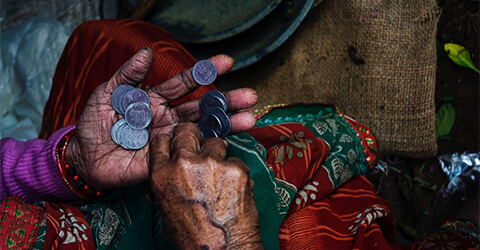According to WHO, 1 in 3 people globally do not have access to safe drinking water. Simple technologies like Life Sack, which help purify water, can significantly impact the developing world. Technological inventions like these that are helpful, reliable, and, most importantly, cheap offerings can cater to these communities to catalyze markets and improve economies, ultimately changing lives and transforming regions.
It all comes down to this single question: Which technologies can have a similar impact?
According to the World Bank, information and communication technologies (ICTs) can be a force multiplier in ending extreme poverty. Many NGOs and Social Entrepreneurs are working to aid these poverty-struck regions and empower families. Here are four ways technology is currently helping alleviate poverty.
- Financial Planning
According to the World Bank, about 9.2% of the world lives in extreme poverty on less than $1.90 a day. To overcome this, Poverty Stoplight is a tool that helps families start planning financially for their future. The tool uses a technology platform to offer a self-assessment survey and intervention model that enables people to develop practical solutions to their specific needs.
By taking the survey, a family assesses their poverty level in 50 specific indicators, and the results are visualized in a dashboard for the family to use. A family may have an income gap or health problems that they would like to tackle. Each family is then allowed to take ownership of their situation and make a family plan based on their priorities and practical solutions available.
Based on this plan, the organization then shares these patterns with existing service providers in the community – NGOs and others willing to help. They can then lend support to these families to achieve their goals and successfully come out of poverty.
- Access To Education
According to UNESCO, globally, out of 787 million children of primary school age, 8% do not go to school; that’s 58.4 million children. To help bridge this gap, The MGCubed Project uses solar-powered and satellite-enabled distance learning infrastructure to deliver interactive learning sessions to students at par with global education. This initiative also helps educate teachers and communities to earn a living wage.
The MGCubed Project has impacted over 36,000 pupils in the past three years and aims at increasing its reach to over 18,000 primaries, Junior High school and out of school girls in the next four years.
- Sewage-Free Sanitation Systems
According to WHO, almost 4.2 billion people do not have safely managed sanitation services, and 3 billion lack basic hand washing facilities. Without these systems in place, human waste is improperly disposed of in nearby water bodies, which leads to health problems in the local population. The consequences are staggering; WHO estimates that 525,000 children under the age of five die each year from diarrheal illnesses linked to poor sanitation.
Solar Powered Urine Diversion (SPUD) Toilets were introduced in India to combat this. It comes attached with a solar-powered fan which dries the human waste and excreta instead of flushing it out the conventional way. The fan runs continuously for 24 hours to dry the faeces completely. Once the excreta is dried, it will be put into a bucket, where it will eventually become manure and can be used in farming.
- Access To Healthcare
According to WHO and the World Bank, half the world lacks access to essential health services. To combat this, Dr Mapham created Vula, a mobile app. This app streamlines the diagnostic process by connecting primary health care workers who live in more rural areas with specialists who can quickly diagnose problems like cataracts.
All the primary healthcare worker needs is a phone with a camera—by snapping a couple of pictures of the patient, the specialist can diagnose the problem and give advice on treatment options. Vula has expanded its diagnostic capabilities to cardiology, orthopedics, HIV, and dermatology and intends to treat all diseases soon.
Conclusively, as Narendra Modi, Prime Minister of India, said, “Technology transforms people’s lives. From mitigating poverty to simplifying processes, Technology is omnipresent. It has become the single-most-important instrument of human progress.”








